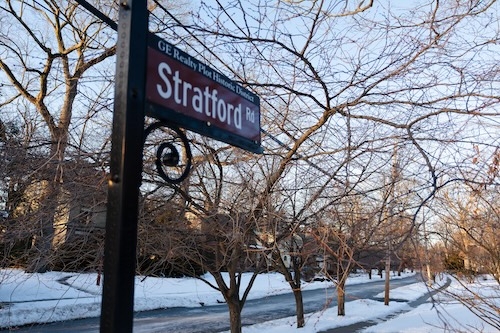A city’s street trees offer a myriad of environmental and psychological benefits, including shade, habitat and food for wildlife, and reducing pollutants in the air.
Yet some neighborhoods in the city of Schenectady have significantly more tree-lined streets than others.
Blame the environmental injustice on discriminatory federal housing policies dating back decades for the disparity in the tree canopy.
New research by Allison Malatesta ’24 and Jeff Corbin, the Florence B. Sherwood Professor of Life Sciences, show that parts of Schenectady that were redlined have, to this day, fewer and smaller trees than other areas of the city.
Their research has been published in the journal Urban Forestry & Urban Greening.
“Allie's research is a unique blend of ecology with social science, as we wouldn't understand the factors that determine tree planting unless we also considered political and racial history,” Corbin said.
In the 1930s, the Home Owners’ Loan Corporation graded areas across the United States based on their risk for defaulting on mortgage loans, with A being the least risk and D regarded as the highest risk. The since-abolished practice targeted Black Americans and other disadvantaged racial groups, giving their neighborhoods the lowest grades and shading them in red.
For their methodology, Malatesta said they took a current map of Schenectady and overlaid it with the redlining map created by the HOLC to determine which streets were in which districts. They then used a 2021 city-wide tree inventory that documented every individual street tree and compared the size, number and diversity of trees within various HOLC grades.
They also did some field work, surveying various neighborhoods.
There are about 137 tree species throughout Schenectady, with the most common ones being Norway maple, Silver maple and Red maple.
In analyzing the data, the researchers discovered that the lower-graded areas had about half the number of trees as the higher-rated areas. The trees in lower-graded areas were also smaller and were the least taxonomically diverse.
“We found that neighborhoods that had been redlined had fewer and smaller trees compared to higher-rated neighborhoods, as well as lower species diversity,” Malatesta said.
The research mirrors studies done in other urban cities, including Baltimore.
A biology major with a double minor in psychology and French, Malatesta got the idea for the project in part when she went on a term abroad to Australia. It was also her senior thesis.
“Part of our coursework was an Urban Ecology class, and we did a project on how socioeconomic status impacted the flora of a neighborhood,” she said. “When I got back from that term and started meeting with professors about my thesis, the idea came up in conversation with Professor Corbin.”
After graduating from Union in June, Malatesta is taking a year off from her studies before pursuing a graduate degree, likely in conservation/marine biology.
Though the disparity in tree canopy was stark between Schenectady neighborhoods based on the HOLC maps, researchers found a silver lining.
“Our most hopeful finding is that public policy is addressing the unequal sharing of environmental benefits brought from street trees,” Malatesta said. “It was important to me to document this inequity, to back up the importance of the impactful work that is being done to remedy the entrenched environmental injustice.”
Corbin agrees.
“What's exciting about Allie's work is that it shows that work by volunteers in Schenectady, particularly ReTree Schenectady, is making progress to overcome those legacies of the past,” Corbin said. “Trees are now being planted, preferentially, in the redlined areas of town, where tree cover and biodiversity are lower. Everyone benefits when a tree is planted, but we want to make sure that those benefits are spread around to all residents.”


